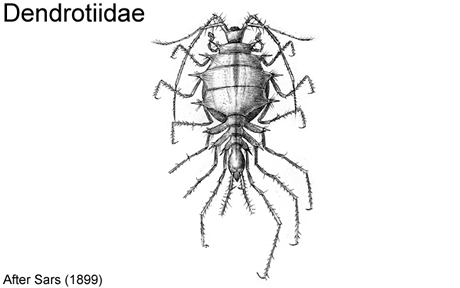 |
||||||
|
|
|
|
|
|
Australian Isopoda: FamiliesS.J. Keable, G.C.B. Poore & G.D.F. WilsonDendrotiidae Vanhöffen, 1914 Dendrotionidae Vanhöffen, 1914: 569. Dendrotiidae. -Cohen, 1998: 2. Description. Body. Body shape without loss or gross modification of appendages on one side of the body; in dorsal view without peduncular articles of antenna 1 or 2 contiguous with coxal margins. Head. Head not capable of lateral rotation (laterally encompassed, abutting or fused to pereonite 1); laterally projecting tergal processes or lappets absent. Antenna 1 inserting on head anteriorly and/or dorsally to antenna 2, minute or well developed; not as follows: reduced to 2 articles with second article expanded and scalloped. Antenna 2 well developed; peduncle article 3 subequal in length and colinear to other proximal peduncle articles. Mouthparts not forming suctorial cone or proboscis. Mandible not projecting anteriorly and together forceps-like; molar distally broad and truncate; palp present. Pereon. Pereonites 5-7 not forming distinct natasome by fusion with each other, pleonites and pleotelson. Pereonites 6-7 pereonite 7 distinct dorsally, free. Coxae not extending ventrally and laterally to overhang the coxa-basis articulation of the pereopods. Pereopods 6-7 pairs readily apparent; 1-3 or 1-7 not prehensile; 1 prehensile; 2-7 similar, ambulatory. Pereopod 1 not subchelate or if subchelate then propodus and carpus opposing each other and dactylus short. Pereopods 5-7 without flattened setose articles andor dactyls modified or absent. Pleon / Pleotelson. Pleonites and pleotelson with pleonites 3-5 fused without lateral sutures, pleotelson fused with pleonites 3-5, pleonites 1 and 2 free but may be only small rings or cuticular bars visible ventrally. Pleopods 5 pairs present (males), or 4 pairs present (females); pleopods 1-2 opercular or not opercular in males, pleopod 2 fused and usually opercular in females. Pleopod 2 of males consisting of an enlarged peduncle, a geniculate endopod and a small muscular exopod. Uropods positioned distally on pleotelson; inserting on dorsal lateral surface of pleotelson (leaving distinct dorsal socket when removed); distinct from pleopods, not forming operculum over pleopodal chamber (although may be folded ventrally below pleotelson). Peduncle not forming an elongate clavate article with rami reduced or absent; elongate (often longer than pleotelson), socket for insertion on pleotelson large and projecting (obvious when uropods missing). Endopod not claw-like (acute and recurved) andor posteroventral in position. Exopod not folded dorsally over pleotelson. Distribution and generic composition. See Kensley et al. (1996).
Cite this publication as: 'S.J. Keable, G.C.B. Poore & G.D.F. Wilson (2002 onwards). 'Australian Isopoda: Families. Version: 2 October 2002. https://crustacea.net'. |
|
|
|
|
|
|
|
|
|
Copyright © Australian Museum, 2002 - 2003
Australian Museum website
